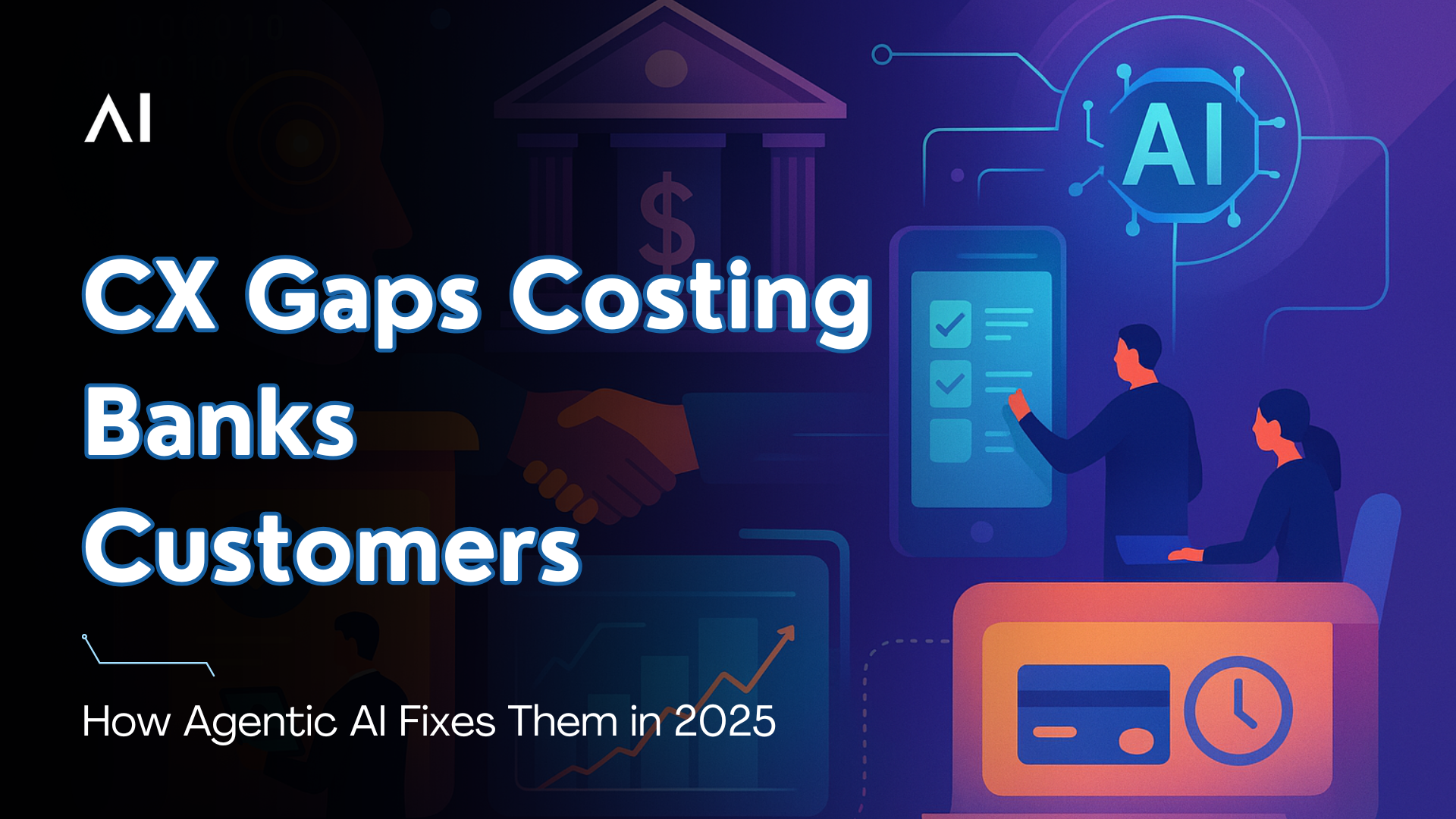Join our WhatsApp Community
AI-powered WhatsApp community for insights, support, and real-time collaboration.
Banks risk losing customers in 2025 due to CX gaps. Agentic AI bridges systems, automates workflows, and delivers seamless, personalized banking at scale.

| Why is AI important in the banking sector? | The shift from traditional in-person banking to online and mobile platforms has increased customer demand for instant, personalized service. |
| AI Virtual Assistants in Focus: | Banks are investing in AI-driven virtual assistants to create hyper-personalised, real-time solutions that improve customer experiences. |
| What is the top challenge of using AI in banking? | Inefficiencies like higher Average Handling Time (AHT), lack of real-time data, and limited personalization hinder existing customer service strategies. |
| Limits of Traditional Automation: | Automated systems need more nuanced queries, making them less effective for high-value customers with complex needs. |
| What are the benefits of AI chatbots in Banking? | AI virtual assistants enhance efficiency, reduce operational costs, and empower CSRs by handling repetitive tasks and offering personalized interactions. |
| Future Outlook of AI-enabled Virtual Assistants: | AI will transform the role of CSRs into more strategic, relationship-focused positions while continuing to elevate the customer experience in banking. |
Banks don’t lose customers overnight—they lose them through small, frustrating moments. An onboarding process that takes days instead of minutes. A fraud claim that requires customers to repeat themselves across three different agents. A loan inquiry that sits in someone’s inbox for weeks.
These gaps—between channels, between systems, between promises and delivery—compound into customer churn. According to industry estimates, poor customer experience accounts for billions in lost revenue annually for banks and credit unions.
Agentic AI changes the equation. Instead of static chatbots that “answer FAQs,” these systems operate as intelligent agents: reasoning, acting, and coordinating across back-end systems to close the gap in real time.
To see how this evolution compares with traditional customer support tools, check out our blog on loopback AI agents replacing static customer support

The Gap: Customers expect to open accounts in minutes. Yet most banks still require manual KYC checks, document uploads, and multiple verification steps that stretch into days. Every extra step increases drop-off rates.
Why It Hurts: Digital-first fintechs like Revolut and Chime can onboard customers in minutes. When legacy banks take longer, they lose high-value younger customers before the relationship even begins.
How Agentic AI Closes It:
Result: Onboarding that once took 5 days now takes under 5 minutes.
For a deeper look at how banks are reimagining digital-first customer engagement, explore our take on AI banking avatars.
The Gap: A customer reports a suspicious transaction. They’re bounced between the call center, fraud desk, and branch follow-up. Each department repeats the same verification steps.
Why It Hurts: Fraud is already emotionally stressful for customers. Slow or repetitive resolution erodes trust. Many customers switch banks after just one unresolved fraud case.
How Agentic AI Closes It:
Result: Customers feel protected and valued, while fraud teams save hours in manual investigations.
The Gap: Applying for a loan often means waiting weeks for underwriters to collect documents, analyze risk, and approve terms. Customers get anxious, drop off, or turn to faster fintech lenders.
Why It Hurts: Loans are one of the most profitable lines for banks. A broken loan CX means losing both immediate revenue and future relationship depth.
How Agentic AI Closes It:
Result: Banks shorten approval times from weeks to hours, closing the competitive gap with fintech lenders.
The Gap: Customers start a request in-app, follow up by phone, and end up repeating themselves in-branch. Data doesn’t flow across systems. Context is lost at every handoff.
Why It Hurts: Customers increasingly expect Netflix-like continuity: start anywhere, continue anywhere, with no loss of context. Inconsistent service makes banks look outdated and careless.
How Agentic AI Closes It:
Result: Frictionless continuity across channels builds trust and loyalty, turning everyday interactions into retention drivers.
You might also enjoy our deep dive into how Agentic AI is quietly replacing banks’ customer support

The Gap: Banks send generic offers—credit cards to retirees, student loans to young professionals with steady jobs. Personalization is surface-level, not contextual.
Why It Hurts: Customers feel unseen, and fintech challengers offer hyper-targeted products with far higher conversion rates.
How Agentic AI Closes It:
Result: Offers that are relevant, timely, and actionable, driving both adoption and customer delight.
Traditional banking AI tools focused on one slice of the customer journey: chatbots for FAQs, fraud models for detection, CRM for outreach. The gaps remained.
Agentic AI is different because it’s:
This makes Agentic AI not just another add-on, but a bridge across the cracks in banking CX.
For decades, banks have measured AI’s success in efficiency gains—faster call resolutions, reduced fraud losses, higher automation percentages. While these metrics matter, they don’t fully capture what customers actually value: trust, personalization, and continuity. This is where Agentic AI takes a decisive leap forward.
Unlike legacy tools that treat every interaction as isolated, Agentic AI threads context across the entire relationship lifecycle. When a customer who just disputed a fraudulent transaction later applies for a new card, the agent doesn’t start from zero—it already “remembers” the journey, tailors the interaction accordingly, and factors in risk models in real time. That continuity transforms what would have been a fragmented, frustrating experience into a moment of reassurance and loyalty.
Agentic AI also enables proactive care. By orchestrating data from core banking systems, transaction histories, and even external feeds like credit bureaus or market signals, it can anticipate needs before they arise. A customer nearing a loan EMI deadline could receive an intelligent nudge with repayment options, or a small business facing seasonal cash flow dips could be offered customized credit support without ever asking.
The difference is subtle but powerful: instead of being reactive problem-solvers, banks become proactive partners. Agentic AI shifts the perception of AI from “automation” to “advocacy.” Customers don’t just get service; they feel seen, understood, and valued.
Banks can’t afford to lose customers in the small gaps anymore. Fintechs and digital challengers have set a high bar: instant, seamless, personalized service.
Agentic AI is the only technology designed to close those gaps at scale—not just with faster responses, but with autonomous, multi-system actions that turn broken journeys into seamless experiences.
In 2025, the banks that thrive won’t be those with the biggest branches or biggest ad budgets. They’ll be the ones that quietly fix the leaks—closing CX gaps with Agentic AI before customers even notice them.
Fluid AI is an AI company based in Mumbai. We help organizations kickstart their AI journey. If you’re seeking a solution for your organization to enhance customer support, boost employee productivity and make the most of your organization’s data, look no further.
Take the first step on this exciting journey by booking a Free Discovery Call with us today and let us help you make your organization future-ready and unlock the full potential of AI for your organization.

AI-powered WhatsApp community for insights, support, and real-time collaboration.
.webp)
.webp)

Join leading businesses using the
Agentic AI Platform to drive efficiency, innovation, and growth.
AI-powered WhatsApp community for insights, support, and real-time collaboration.